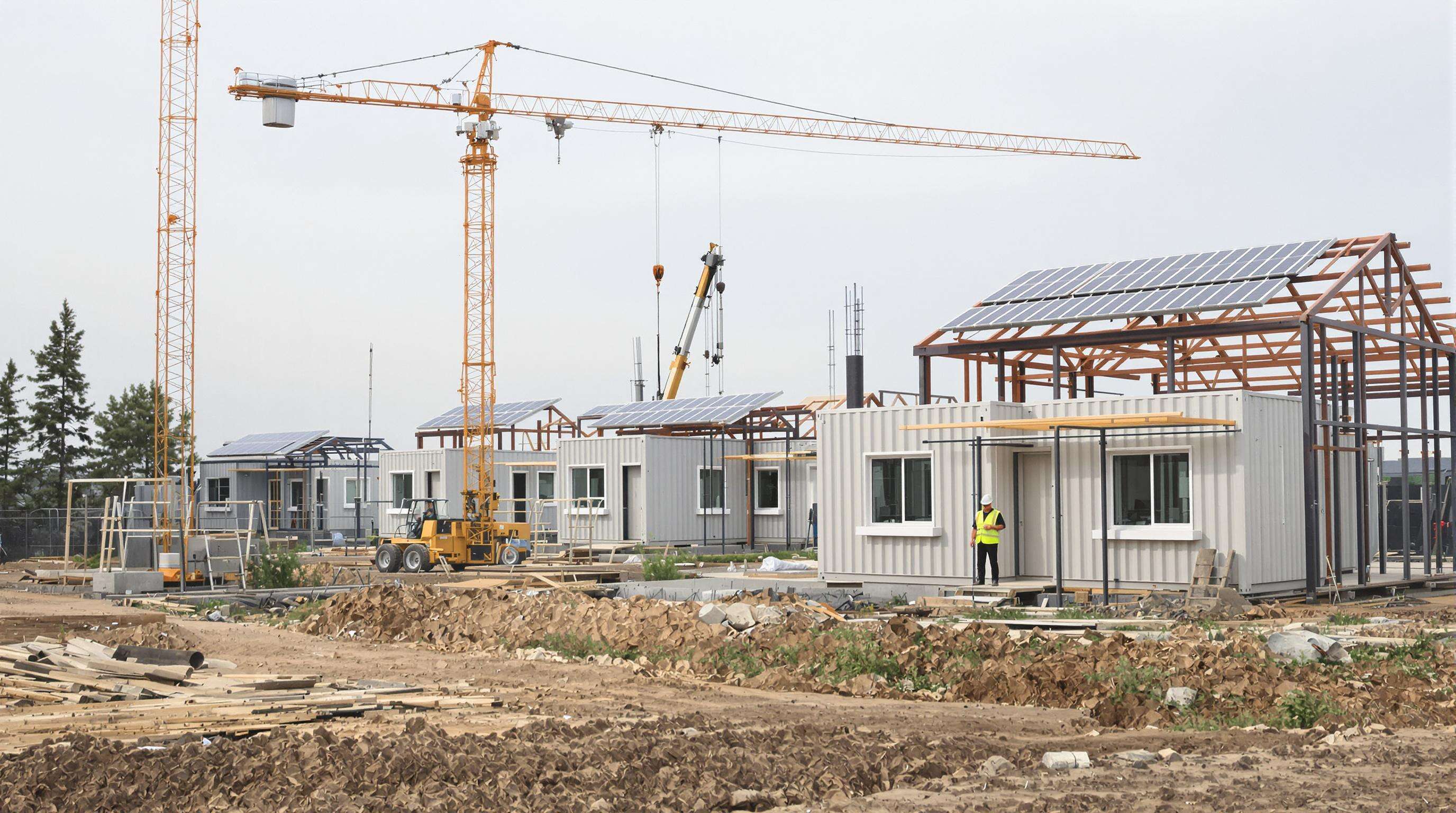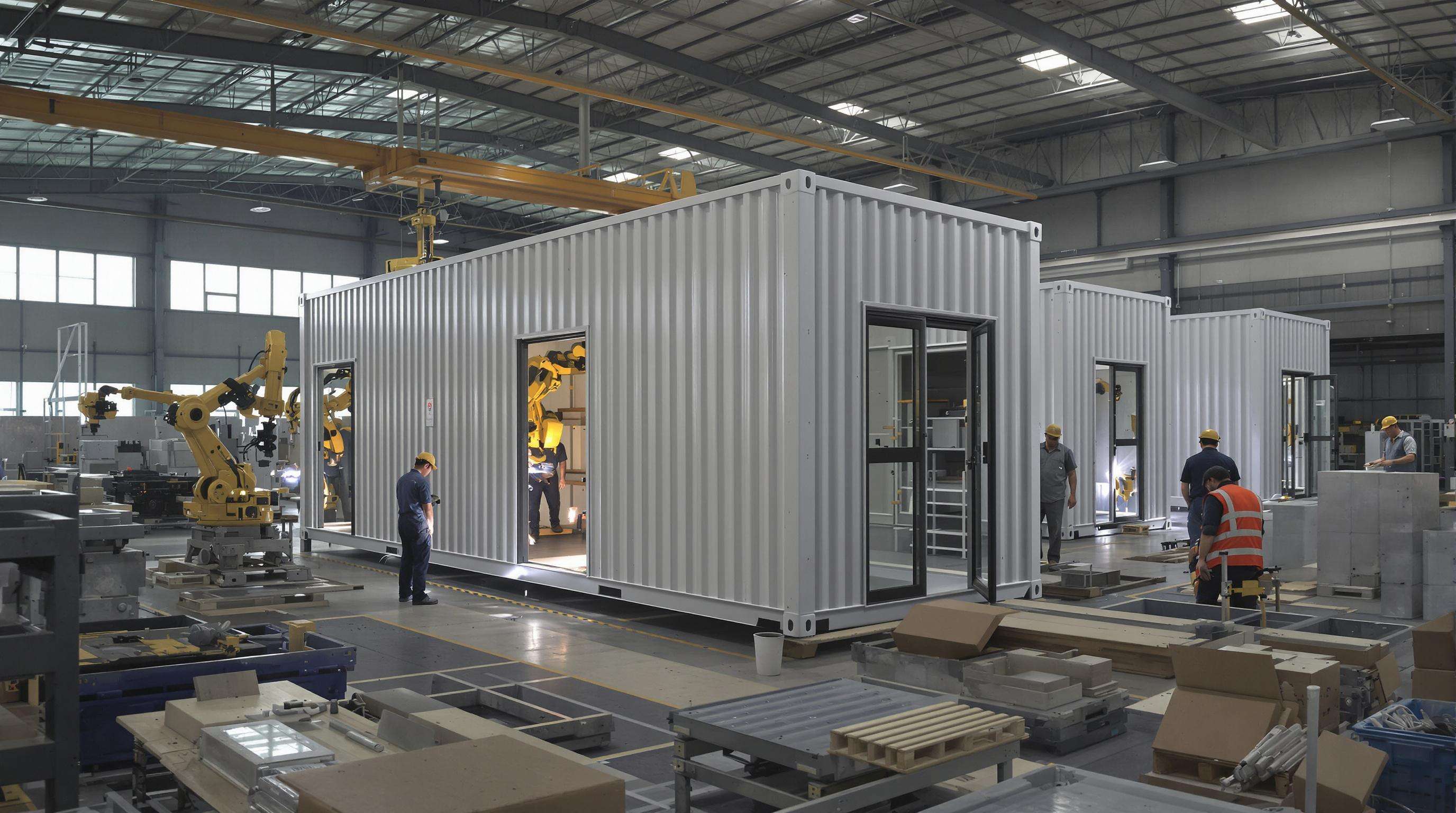Რატომ არის კონტეინერული სახლები იაფი და მდგრადი საცხოვრებელი სივრცის მომავალი

Კონტეინერული სახლების ხარჯთა ეფექტურობა ტრადიციული სახლების შედარებით
Კონტეინერული სახლების აშენება ფულის დაშენებას უზრუნველყოფს ჩვეულებრივი სახლების შედარებით. უმეტესი პროექტის ღირებულება ერთ კვადრატულ ფუტზე დაახლოებით 100 აშშ დოლარიდან 200 აშშ დოლარამდე მერყეობს, ხოლო ტრადიციული მშენებლობების შემთხვევაში ეს მაჩვენებელი ჩვეულებრივ 150-დან 300 აშშ დოლარამდეა. როდესაც ძველი სატვირთო კონტეინერები ხელახლა გამოიყენება, ნარჩენების რაოდენობა შემცირდება და მუშაობის დრო დაახლოებით 30-50% შემცირდება, ვინაიდან ყველაფერი მზად მიდის. საბაზო და სწორი იზოლაცია აუცილებლად ამატებს საბოლოო ფასს, თუმცა ასეთი სტრუქტურების ასაშენად საჭირო დრო 3-დან 6 თვემდე მერყეობს. ეს დრო დაახლოებით ორმაგად ნაკლებია იმ სტანდარტული სახლის აშენების დროზე, რომელიც თითოეული ნაწილისგან ხდება. ამის შედეგად, ადამიანებს არ უწევთ საიპოთეკო გადასახადების გადახდის არაუცილებლობა მშენებლობის პროცესში. ეს მიდგომა საშუალებას აძლევს ადამიანებს სახლის მფლობელობაში შევიდნენ და არ დახარჯონ მაღალი თანხები, განსაკუთრებით იმ ადამიანებისთვის, რომლებიც დაწყებული არიან და სურთ მყარი, მაგრამ იაფი სახლის მიღება გრძელვადიან პერიოდში.
Გამეორებით გამოყენებული კონტეინერების გარემოზე დადებითი ზემოქმედება და მდგრადობა
Მოხმარებული სატრანსპორტო კონტეინერის ხელახლა გამოყენებით ავიცილებთ დაახლოებით 3,500 კილოგრამი ფოლადის მასალის გადამუშაობას და შევნარჩუნებთ დაახლოებით 7,000 კილოვატ-საათის ტოლ ენერგიას, რომელიც საჭიროა ახალი მშენებლობის შესაქმნელად, მონაცემები წარმოდგენილია 2024 წელს მსოფლიო ფოლადის ასოციაციის მიერ. კონტეინერულ სახლებს ახასიათებთ მოდულური თვისებები, რის გამოც მშენებლობის ადგილებზე ნაკლები არეულობა ხდება, რაც ხელს უწყობს ადგილობრივი ველური ბუნების გადარჩენას გრძელ ვადაში. თუ ამ კონტეინერებს შევუერთებთ პასიური მზის გათბობის სისტემებს, წვიმის წყლის შეგროვების ტანკებს, ასევე გამათბებელ მასალებს, რომლებიც გარემოზე უარყოფით ზემოქმედებას არ ახდენენ, მივიღებთ სახლებს, რომლებიც საკუთარი სიცოცხლის განმავლობაში დაახლოებით ორმოცი პროცენტით ნაკლებ ნახშირორჟანგს ამოჰყავს. გარდა ამისა, თვითონ კონტეინერები შესაძლოა მოგვიანებით ხელახლა გამოყენებულ იქნას, რაც სრულიად ერგება წრიული ეკონომიკის მოდელს, რომელსაც ამ დროს მრავალი გრინ ინიციატივა უჭერს მხარს, ამიტომ ისინი საუკეთესო არჩევანია იმ ადამიანებისთვის, ვისაც განვითარება საიმედო მომდევნოში აინტერესებს.
Მოთხოვნა კონტეინერული სახლების მიმართ 2022 წელიდან 87 პროცენტით გაიზარდა, რაც გავრცელდა როგორც ხარჯოვან ქალაქებში, ასევე შორს მდებარე სოფლებში. მაგალითად, ტოკიოში ბოლო წელის შემდეგ ორ ასეულ კონტეინერზე მეტი იქნა გამოყენებული ურბანული სივრცეების მოსაწყობად, სადაც ადამიანები მცირე, მაგრამ გონივრული დიზაინით ამართეს სივრცეები შეზღუდული ნებისმიერი იმის არსებობის გამო. ჩრდილოეთით, ალბერტას მსგავს ადგილებში, ყოველწლიურად ერთი მესამედით მეტი კონტეინერული სახლი იკეთება, რადგან ადამიანები იძებენ იაფ საცხოვრებელ ადგილს და სურთ თავისუფალი იყვნენ ქსელისგან. ამ დროს, სამუშაო ადგილების უმეტესობა უკვე შესაძლებლობას გვაძლევს მოხდეს სახლიდან მუშაობა, რის გამოც მცირე სტუდიების გარდაქმნა მთელ საზოგადოებებში მომხდარა, სადაც ცხოვრობენ როგორც მხატვარები, რომლებსაც სჭირდებათ იაფი სტუდიო, ასევე პენსიონერები, რომლებიც ეძებენ იაფ და მისაღებ პენსიის ვარიანტებს. ამ ტრენდის გავრცელება კი უფრო სწრაფად მიმდინარეობს, ვიდრე ველოდით.
Ქალაქურ და სოფლის მოსახლეობის ბაზრებზე ზრდადი პოპულარობა
2025 წლის 5 ხელმისაწვდომი კონტეინერული სახლის დიზაინი
1. მინიმალისტური სტუდიის კონტეინერი Მთავარი : კომპაქტური და ხელმისაწვდომი ბიუჯეტით
Ერთი კონტეინერისგან აგებული სახლები ბოლო დროს მოთხოვნაშია ხელმისაწვდომი საცხოვრებელი ადგილების კატეგორიაში. ასეთი საცხოვრებელი ადგილების ფართი საშუალოდ 300 კვადრატული ფუტია და ისინი 50-60%-ით იაფია ჩვეულებრივი სტუდიების გასაყიდ ბინებთან შედარებით. ჭკვიანი ადამიანები, რომლებიც ამ სივრცეებში ცხოვრობენ, იპოვეს გზები სივრცის დასაზოგად ყველგან, სადაც შეიძლება. მაგალითად, გადასაგდები მაგიდები, მარვის საწოლები და კედელზე მიმაგრებული საწყობის ამონახსნები მნიშვნელოვან როლს თამაშობს. დიდი გამჭვირვალე სარკმლებიც ხელს უწყობს, რადგან ისინი ბევრ ნათელს შეჰყავს და ამცირებს იმ კლაუსტროფობიულ შთაბეჭდილებას, რომელიც ადამიანებს უწუხებთ. დღესდღეობით საწარმოო ვერსიების ფასი იწყება 35 ათასი დოლარიდან, რომლებიც უკვე ამუშავებული წყალით და ელექტროენერგიით არის დაამატებული. ამიტომ გასაგებია, რატომ არის ამ ტრენდზე მოხალისე ბევრი ახალგაზრდა პროფესიონალი და სტუდენტი, როდესაც ქირა უფრო მაღალ და უფრო მაღალ მხარეს მიდის.
2. ორ-კონტეინერიანი სახლის დიზაინი: იდეალურია პატარა ოჯახებისთვის
Როდესაც მშენებლები ერთმანეთზე ან გვერდის მიმართულებით ორ სტანდარტულ 40 ფუტიან სატვირთო კონტეინერს აწყობენ, ისინი შიგნით 800 კვადრატული ფუტის სივრცეს ქმნიან, რომელიც იყოფა საცხოვრებელ და საძინებელ ადგილებად. ასეთი განლაგება ხელს უწყობს ხმაურის გავრცელების შეზღუდვას სახლის სხვადასხვა ნაწილში. ბოლო კვლევის მიხედვით, რომელიც 2024 წელს გაიმართა კომპაქტური საცხოვრებელი სივრცეების შესახებ, უმეტესი საოჯახო წევრები მნიშვნელოვანს თვლიან სივრცეების გამიჯვნას დამატებით ადგილზე ვიდრე გაფართოებას. ფოლადის საყრდენი კონსტრუქციები სწორად დამზადებულია და შესაძლებელს ხდის მათ უსაფრთხო გადახურვას სხვადასხვა სიმაღლეზე. უმეტესობას მოეჩვენება, რომ ასეთი სახლის მშენებლობა ხარჯების დიაპაზონში 55,000-დან 85,000 დოლარამდე მოხდება მასალებისა და ადგილმდებარეობის გათვალისწინებით.
3. გაფართოებადი სამ-კონტეინერიანი მოდულური სახლი პირადი დაგეგმვით
Ამ მოქნილი დიზაინის საშუალებით გამოიყენება მოწყობილი კედლები და კავშირის მოდულები, რაც საშუალებას აძლევს მფლობელებს დაიწყონ პატარა და დროთა განმავლობაში გაფართოვონ. ერთი კონტეინერის ბირთვი შეიძლება ჰორიზონტალურად ან ვერტიკალურად გაიზარდოს, რაც საწყის ინვესტიციებს 60,000 დოლარზე ქვემოთ ი hნარჩუნებს. ინჟინერიული სისტემების წინასწარ დაყენებული სივრცეები ივარაუდებს მომდევნო განვითარებას და ხარჯებს შეამცირებს 32%-ით სტანდარტული მოდერნიზაციის შედარებით.
4. ეკო-სახლი კონტეინერიდან მზის პანელებით და მწვანე სახურავით
Ეს მდგრადი მოდელი შეიცავს ოთხ ძირითად თავისებურებას:
- მზის სისტემები 5კვტ (ენერგიის მოხმარების 85%-ის დასაკრიფად)
- Გამოყენებული დენიმის ან ცხვრის ბამბის გათბობა (R-15-დან R-30-მდე რეიტინგი)
- Წვიმის წყლის შეგროვება 500 გალონიანი ავზებით
- Მიდამოს მცენარეებით და მწვანე სახურავით, რომლებიც აკონდიციონერის დატვირთვას 18%-ით ამცირებს
Ეს გაუმჯობესებები საბაზო ხარჯებს 12,000–20,000 დოლარს ამატებს, მაგრამ ყოველწლიურად სასარგებლო ხარჯების 1,200 დოლარზე მეტ დაბრუნებას იძლევა.
5. DIY წინასწარ დამზადებული კონტეინერის სახლის კომპლექტი ხელისუფლების მშენებლებისთვის
Ახლა ხელმისაწვდომია ნომერის მიმაგრებული პანელებით და ვიდეო-დახმარებით დამონტაჟებული სრული კომპლექტები, რომლებმაც შეიძლება შრომის ხარჯები 60%-ით შეამციროს. სტანდარტული 320 კვ. ფტ. კომპლექტი შედგება:
| Კომპონენტი | Სტანდარტული მახასიათებლები |
|---|---|
| Სტენდარტული სისტემა | Წინასწარ დამზადებული სარკმლები, თბოიზოლაცია, ორთქლის ბარიერი |
| Იატაკის კომპლექტი | Ერთმანეთთან დამაგრებული იატაკის პანელები სიტვის საწინააღმდეგო დამუშავებით |
| Სახურავის კომპლექტი | Მონაკვეთებადი ფოლადის სამაგრე კონსტრუქცია მზის მომზადებით |
Აშენების პირველი გამოცდილების მქონე ადამიანები საშუალოდ ამ სახლების აშენებას 12-16 ვიკენდში ასრულებენ, ხოლო საერთო ხარჯები დაახლოებით 28,000 დოლარს უდრის (მიწის გარეშე).
Მთავარი დიზაინისა და მშენებლობის ტენდენციები, რომლებიც კონტეინერული სახლების ხელმისაწვდომობას უზრუნველყოფს

Მოდულური და წინასწარ დამზადებული მშენებლობა დროისა და სამუშაო ხარჯების შემსუბუქებას უზრუნველყოფს
Წინასწარ დამზადებულმა მოდულებმა შეიძლება შეამციროს ხარჯები 15-50%-ით ტრადიციული მშენებლობის შედარებით, რადგან მუშაობა დახურულ საწარმოში ხდება (Tradecorp USA 2024). სამშენებლო ნაგებობების, იატაკების და სახურავების წინასწარ დამზადება ამცირებს სამუშაო ხარჯებს 30-40%-ით, ამცირებს ამინდის გამო გადადებულ დროს და ზუსტი მუშაობის შესაძლებლობას ამაღლებს. ასეთი მეთოდის გამოყენებით პროექტები 25%-ით უფრო სწრაფად იხურება, ვიდრე ჩვეულებრივი მშენებლობა, რაც საოჯახო დატირების აჩქარებას და ხარჯების შემსუბუქებას უზრუნველყოფს.
Ინოვაციური არქიტექტურული დიზაინი სივრცისა და ფუნქციონალურობის მაქსიმიზება
Დიზაინერები ახლა იყენებენ კონსოლურ დარბაზებს, გადატარებულ გამყოფებს და ვერტიკალურ საწყობებს პატარა სივრცეების ოპტიმიზაციისთვის. 2023 წელს ჩატარებულმა გამოკითხვამ აჩვენა, რომ მფლობელების 68%-მა მრავალფუნქციური არეები უპირატესობა მისცა, როგორიცაა გადაკეთებული ავეჯი და შესაბრუნებელი საფეხურები. სარკის ზედაპირების და ფანჯრების სტრატეგიულად განთავსება აძლიერებს სივრცის შთაბეჭდილებას, რაც უმასპინძლებს კომპაქტურ სახლებს გახსნილი და დინამიური იმპრესიის შესახებ.
Დამალული ხარჯების გაგება: სითბოიზოლაცია, ნებართვები და ადგილის მომზადება
| Ხარჯის ფაქტორი | Საშუალო ხარჯთა დიაპაზონი | Ბიუჯეტის სრულ მოცულობაზე ზემოქმედება |
|---|---|---|
| Თერმოიზოლაცია | $3,000 – $8,000 | 10–15% |
| Მშენებლობის ნებართვები | $1,200 – $4,500 | 4–8% |
| Მოედნის მომზადება | 5,000 – 15,000 დოლარი | 12–25% |
Სწორი დაგეგმვა აუცილებელია გადახარჯის თავიდან ასაცილებლად: პენოპლასტის გათბოლის მასალა ფინალურად 25%-ით იაფია მინის ბამბის გათბოლის მასალაზე, ადრეული ნებართვის გაცემის პროცესი კი შეიძლება დაამთავროს დამტკიცების ვადას 3–6 კვირით შეამოკლოს (SVOLTEX 2025 გამყიდველის მიჩვენება). პირველი სახლის მშენებლების თითქმის 40% ადამიანი ავალდებულებს საფუძველზე დახარჯულ თანხას, რომელიც მიწის პირობების მიხედვით 85–150 დოლარს უდრის კვადრატულ ფუტზე.
Როგორ აირჩიოთ თქვენთვის საჭირო კონტეინერის სახლის პროექტი 2025 წელს
Კლიმატისა და ადგილმდებარეობის შესაბამისობის შეფასება კონტეინერში საცხოვრებლად
Ფოლადის შენობები არ არის მგრძნობიარე არც ამ სიცივის და არც სიცხის მიმართ, რაც იმას ნიშნავს, რომ კარგი იზოლაცია არის საჭირო. დახურული უჯრედის სპრეი ბეტონი კი მუშაობს კარგად, რომელიც 2025 წელს Green Builder-ის მონაცემებით 1 კვადრატული ფუტის დაახლოებით $3.50 ღირს. სახლების შემთხვევაში, რომლებიც სანაპიროზე მდებარეობს, ხშირად იყენებენ ნაღვლის წინააღმდეგ მასალებს, როგორიცაა ფოლადის კორტენი ან სპეციალური დამცავი საფარი. მთებში კი უფრო მაგარი სახურავის კონსტრუქციები ხდება საჭირო ყინულის გამო, რადგან ზამთრის თვეებში თოვლი იკოპება. სანამ ნებისმიერი ადგილის გათხრა მოხდება, ჭკვიანურია ქარის მიმართულებების შემოწმება და მიწის პირობების გამოკვლევა, განსაკუთრებით თუ სახლი მდებარეობს წყალქვეშ არის. ამ ადგილებში საფუძველის აწევა საერთო ბიუჯეტში დაახლოებით 8000-დან 12000 დოლარამდე იმატებს. კარგი ამბების შესახებ კი ის არის, რომ ახალი პროგრამული უზრუნველყოფა იწყებს ადგილობრივი კლიმატის მონაცემების შესასწავლად, რათა არქიტექტორებმა გამოთვალონ სიმულაციები სხვადასხვა დიზაინის მუშაობის შესახებ, რათა სახლების მართილად განლაგება მზის გამოცხადების და სხვა გარემოს პირობების გათვალისწინებით.
Იაფი მასალების, ხელმუშაობის და სანებართვო ნებართვების და ხელსაწყოების ბალანსირება
Ნებართვები სრული პროექტის ხარჯების 17–25%-ს შეადგენს (Prefab Council 2024), ხოლო საზონე წესები მუნიციპალიტეტების მიხედვით საგრძნობლად განსხვავდება. მასალების არჩევისას შეადარეთ:
- Მზა და სახლის მშენებლობის შორის ხელმუშაობის ეფექტურობა
- Გამოყენებული მასალები გარემოს დაცვისა და შესაძლო ხარჯების შესამსუბუქებლად
- Კლადინგისა და იზოლაციის არჩევანის და ხანგრძლივობის მიხედვით
Სტრუქტურული გაუმჯობესებების გაკეთება საწყის კონვერტაციისას – მოგვიანებით რეტრო მოდიფიკაცია ხარჯებს 120%-ით შეიძლება გაზარდოს. გარდა ამისა, აშშ-ის 22 შტატში უკვე არის სახლის მშენებლობის სუბსიდიები ან გადასახადების დაბრუნება იაფი კონტეინერული სახლებისთვის, რაც ეხმარება იზოლაციისა და ნებართვების ხარჯების შესამსუბუქებლად.
Შესწავლის შემთხვევა: ოჯახის მოგზაურობა იაფი კონტეინერული სახლის მშენებლობაში
Რივერასი მუშაობდა ამერიკული პატარა სახლის ასოციაციის (ATHA) სერტიფიცირებულ დიზაინერთან ერთად რეგულატორული გამოწვევების გადასალახად. მათი სტრატეგია შედგებოდა:
- Გრანტის ციკლების მიხედვით მშენებლობის დაგეგმვა ($28,000 დაზოგილი მიღწეულია გრინ ჰაუსინგ ინიციატივების საშუალებით)
- Კონტეინერების მიწოდება ინდუსტრიული აუქციონების მეშვეობით (2,400 დოლარი ერთეულზე)
- Მოდულური ექსპერტებთან პარტნიორობა პასიური მზის ორიენტაციის ოპტიმიზაციისთვის
Მათი ბოლო სტუდია ერთ-ერთი კონტეინერით დაჯდა 62,000 დოლარი – 43%-ით ნაკლები ვიდრე ტრადიციული მშენებლობა – ხელისუფლების მიღებული ცედრის გვერდითი და ხელისუფლების სანტექნიკის წყალობით. დასახლების შემდგომი მონიტორინგი აჩვენებს 1,900 დოლარის წელზე შენახვას კომუნალურ გადასახადებში, რაც აჩვენებს, თუ როგორ უნდა გადაიქცეს სტრატეგიული გეგმები ფოლადის კონტეინერები მაღალი ეფექტურობის, დაბალი ხარჯების სახლებში.
Ხელიკრული
Იაფია თუ არა კონტეინერული სახლები ვიდრე ტრადიციული სახლები?
Დიახ, კონტეინერული სახლები ხშირად უფრო იაფია ტრადიციული სახლებთან შედარებით, ხშირად ჯდება 100-დან 200 დოლარამდე კვადრატულ ფუტზე, იმ შემთხვევაში, თუ ტრადიციული მშენებლობისთვის საჭიროა 150-დან 300 დოლარამდე.
Რამდენი ხანი სჭირდება კონტეინერული სახლის ასაშენად?
Კონტეინერული სახლის მშენებლობა ჩვეულებრივ იღებს 3-დან 6 თვემდე, რაც მნიშვნელოვნად უფრო სწრაფია ტრადიციული სახლებთან შედარებით, რომლებსაც ხშირად სჭირდებათ გრძელი მშენებლობის დრო.
Შეიძლება თუ არა კონტეინერული სახლების მადლიერება?
Რა თქმა უნდა! კონტეინერული სახლები შეიძლება იყოს გამძლე, რითიც შეიძლება შევამციროთ ნაგავი, დავზოგოთ ენერგია და შევამციროთ ნახშირორის გამოყოფა მათი სიცოცხლის განმავლობაში.
Რა არის დამალული ხარჯები კონტეინერული სახლის აშენებისას?
Დამალული ხარჯები შეიძლება შედგებოდეს თერმოიზოლაციის, სამშენებლო ნებართვების და ადგილის მომზადების საფასურისგან, რამაც შეიძლება მნიშვნელოვნად მოახდინოს საერთო ბიუჯეტზე ზემოქმედება.
Შინაარსის ცხრილი
-
Რატომ არის კონტეინერული სახლები იაფი და მდგრადი საცხოვრებელი სივრცის მომავალი
- Კონტეინერული სახლების ხარჯთა ეფექტურობა ტრადიციული სახლების შედარებით
- Გამეორებით გამოყენებული კონტეინერების გარემოზე დადებითი ზემოქმედება და მდგრადობა
- Მოთხოვნა კონტეინერული სახლების მიმართ 2022 წელიდან 87 პროცენტით გაიზარდა, რაც გავრცელდა როგორც ხარჯოვან ქალაქებში, ასევე შორს მდებარე სოფლებში. მაგალითად, ტოკიოში ბოლო წელის შემდეგ ორ ასეულ კონტეინერზე მეტი იქნა გამოყენებული ურბანული სივრცეების მოსაწყობად, სადაც ადამიანები მცირე, მაგრამ გონივრული დიზაინით ამართეს სივრცეები შეზღუდული ნებისმიერი იმის არსებობის გამო. ჩრდილოეთით, ალბერტას მსგავს ადგილებში, ყოველწლიურად ერთი მესამედით მეტი კონტეინერული სახლი იკეთება, რადგან ადამიანები იძებენ იაფ საცხოვრებელ ადგილს და სურთ თავისუფალი იყვნენ ქსელისგან. ამ დროს, სამუშაო ადგილების უმეტესობა უკვე შესაძლებლობას გვაძლევს მოხდეს სახლიდან მუშაობა, რის გამოც მცირე სტუდიების გარდაქმნა მთელ საზოგადოებებში მომხდარა, სადაც ცხოვრობენ როგორც მხატვარები, რომლებსაც სჭირდებათ იაფი სტუდიო, ასევე პენსიონერები, რომლებიც ეძებენ იაფ და მისაღებ პენსიის ვარიანტებს. ამ ტრენდის გავრცელება კი უფრო სწრაფად მიმდინარეობს, ვიდრე ველოდით.
-
2025 წლის 5 ხელმისაწვდომი კონტეინერული სახლის დიზაინი
- 1. მინიმალისტური სტუდიის კონტეინერი Მთავარი : კომპაქტური და ხელმისაწვდომი ბიუჯეტით
- 2. ორ-კონტეინერიანი სახლის დიზაინი: იდეალურია პატარა ოჯახებისთვის
- 3. გაფართოებადი სამ-კონტეინერიანი მოდულური სახლი პირადი დაგეგმვით
- 4. ეკო-სახლი კონტეინერიდან მზის პანელებით და მწვანე სახურავით
- 5. DIY წინასწარ დამზადებული კონტეინერის სახლის კომპლექტი ხელისუფლების მშენებლებისთვის
- Მთავარი დიზაინისა და მშენებლობის ტენდენციები, რომლებიც კონტეინერული სახლების ხელმისაწვდომობას უზრუნველყოფს
- Როგორ აირჩიოთ თქვენთვის საჭირო კონტეინერის სახლის პროექტი 2025 წელს
- Ხელიკრული

